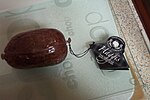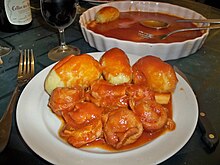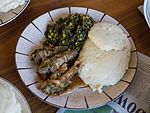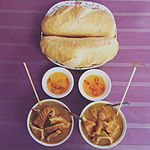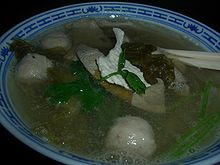Offal
Others remain part of traditional regional cuisine and are consumed especially during holidays; some examples are sweetbread, Jewish chopped liver, Scottish haggis, U.S. chitterlings, and Mexican menudo.
Brawn (the British English term for 'head cheese') is the collection of meat and tissue found on an animal's skull (typically a pig) that is cooked, chilled and set in gelatin.
The Swedish pölsa is made of offal like liver or heart, onions, rolled barley and spices, and is served with boiled potatoes, fried eggs, and sliced beetroot.
One of the most popular offal dishes is verilettu (or veriohukainen or verilätty) which translates to blood pancake, a pan-fried thin bread-like snack traditionally enjoyed with lingonberry jam.
The Bavarian expression Kronfleischküche includes skirt steak and offal as well, e.g., Milzwurst [de], a sausage containing small pieces of spleen, and even dishes based on udder.
Among the most popular are fried or stewed brains; boiled stomach (trippa), often served in a tomato sauce; lampredotto (the fourth stomach of the cow), boiled in broth and seasoned with parsley sauce and chilli; liver (stir-fried with onions, roasted); kidneys; heart and coronaries (coratella [fr; it] or animelle); head, eyes, and testicles of a pig; and several preparations based on chicken entrails.
A festive variety is kokoretsi (from Turkish kokoreç, Macedonian kukurek), traditional for Easter; pieces of lamb offal (liver, heart, lungs, spleen, kidney and fat) are pierced on a spit and covered by washed small intestine wound around in a tube-like fashion, then roasted over a coal fire.
Tzigerosarmas (from Turkish ciğer sarması, meaning "liver wrap") and gardoumba are two varieties of splinantero and kokoretsi made in different sizes and with extra spices.
Head and collagen-rich extremities are used to make kholodets—a version of aspic, whereby these body parts are slowly boiled for several hours with meat and spices, removed and discarded, and the remaining broth is cooled until it congeals.
In Argentina and Uruguay, the traditional asado is often made along with several offal types (called "achuras"), like chinchulines and tripa gorda (chitterlings), mollejas (sweetbreads) and riñón (cow's kidney).
Just like in Argentina, and depending on the region, Colombian asado and picada involve many offal types, including chunchullo (chitterlings), chicken hearts, and bofe (beef lung).
In Chile, the tongue is boiled, sliced and served in a walnut-based sauce in New year and Christmas festivities ("lengua nogada") while the soup is used later to cook a wheat, milk and spice ball mix called "albóndigas de sémola".
Criadillas or huevos de toro ("bull's eggs", testicles) are eaten mostly in cattle-raising regions, while cow udder ("ubres") is served fried or boiled.
Offal dishes in South Africa do not usually consist of any organs and are mostly limited to stomach skin, sheep's head, shin, and very rarely brains.
Beef and goat offal dishes include the stomach, hooves (trotters), shin, intestines, liver, head, tongue, pancreas, lungs, kidneys, udders, and, very rarely in certain communities, testicles.
Braised pork ear strips in soy sauce, five-spice powder and sugar is a common "cold plate" appetizer available as hawker food or in major local supermarkets.
For example, "豬腳薑—Jui Kerk Gieng" (pork feet in sweet vinegar stew) is a popular bowl now besides its traditional function as a supplement for postpartum mother care.
For example, there is the folksy dish of "東江魚雲煲—Tung Gong Yu Wan Bo", a casserole with the lips of freshwater large head fish; and shark fin soup.
The use of the pancreas, liver, kidney, gall bladder, lung and even bronchus of various farm animals together with herbs in Chinese medicine have strong empirical theories and studies are being conducted to try to understand their nature in modern scientific terms.
In Indonesia cow and goat internal organs are popular delicacies, it can be fried, made into soto soups or grilled as satay and almost all of the parts of the animal are eaten.
In Malaysia, cow or goat lung, called paru, coated in turmeric and fried is often served as a side dish to rice, especially in the ever popular nasi lemak.
Dinuguan is a particular type of blood-stew (depending on region) made using pig intestines, pork meat and sometimes ears and cheeks usually with a vinegar base, and green chilli peppers.
Other street food that are prepared in a similar way are pig ears, skin, liver and coagulated blood cut into cubes, and chicken heads, necks, feet, and gizzards.
In the city of Mangalore, a spicy dish called raghti, made of heavily spiced porcine offal and cartilaginous tissue, is considered a homely indulgence by the local Christian community.
The name comes from the word sarapatel meaning ‘confusion’ as the thick gravy is heady with spice, vinegar, and contains the heart, liver, ears, tongue and sometimes the blood of a pig.
Chicken dishes frequently include the gizzard, heart and liver of the bird, and Goan sausage choris or chouriço contains spicy, tangy pork pickled in vinegar and the local liquor feni before being cased in pig intestines.
[23] In Bangladesh, a bull's or goat's brain (mogoj), feet (paya), head (matha), stomach skin (bhuri), tongue (jib-ba), liver (kolija), lungs (fepsha), kidney and heart (gurda) are delicacies.
Pacha (Persian term), is a traditional Iraqi dish made from sheep's head, trotters, and stomach; all boiled slowly and served with bread sunken in the broth.
In Egypt, fried beef and lamb liver (kibda) with a cumin-based coating is a popular dish, most often served in sandwiches with a bit of onion from small shops in most major cities.
Ironically, given its provenance and history, offal has started to be reintroduced as an item of haute cuisine, with stylish restaurants offering roasted bone marrow, fried pork rind, tongue or heart as part of their menus.


